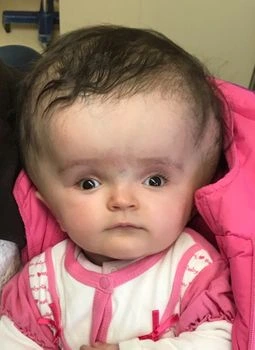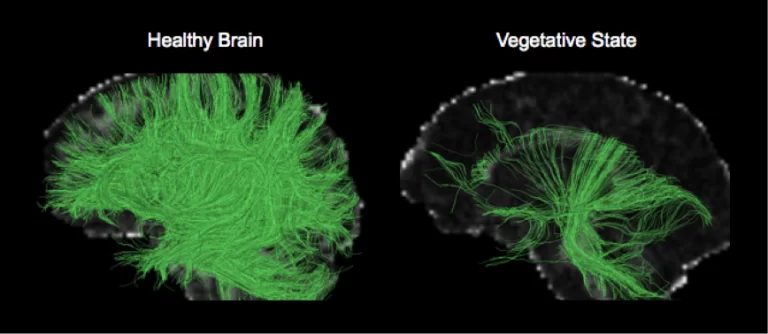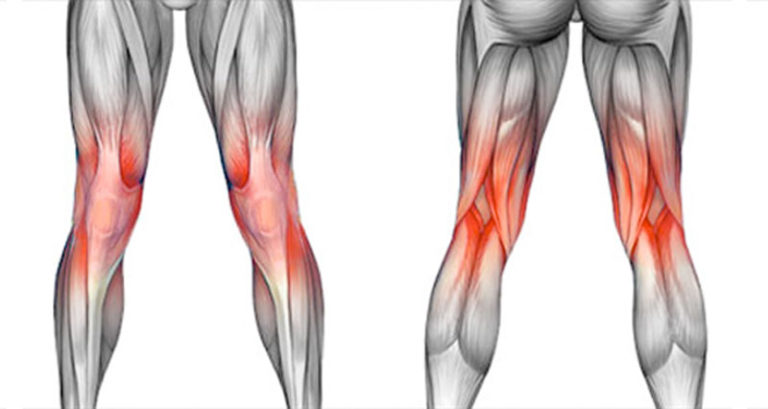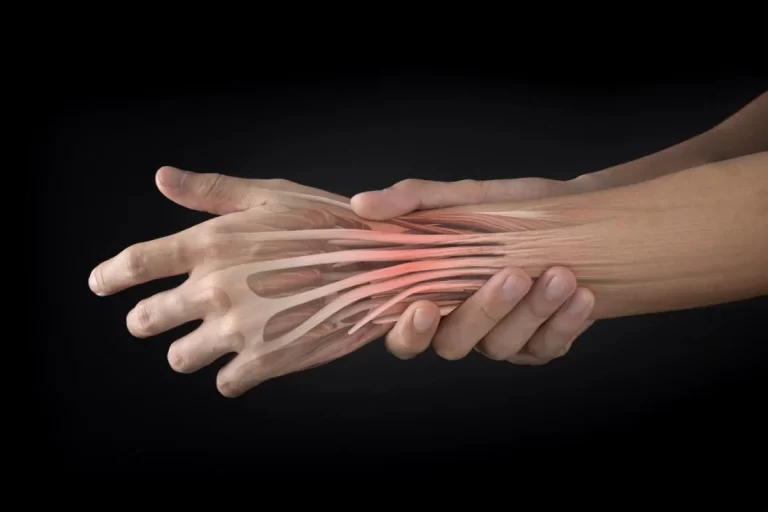Hydrocephalus
What is Hydrocephalus?
Hydrocephalus is a condition in which extra cerebrospinal fluid (CSF) accumulates within the brain’s fluid-containing cavities or ventricles. The term hydrocephalus is derived from the Greek words hydro, which means water, and cephalus, which means head. Although the term translates as “water on the brain,” it refers to the accumulation of cerebrospinal fluid, a clear organic liquid that covers the brain and spinal cord. CSF circulates continuously within the ventricles of the brain and aids in many critical functions:
1) It acts as a buffer for the brain and spinal cord.
2) It functions as a vehicle for delivering nutrients to and extracting waste from the brain.
3) It circulates between the skull and the spine to regulate pressure changes.
When CSF accumulates near the brain, it can exert harmful pressure on the brain tissues located within the skull. CSF collects due to an increase in the fluid’s production, a decrease in its rate of absorption, or a disease that prevents it from flowing normally through the ventricular system.
Hydrocephalus can occur at any age, but it is most common in babies and adults aged 60 and older. According to the National Institute of Neurological Disorders and Stroke (NINDS), hydrocephalus affects one to two out of every 1,000 children born in the United States. The majority of these patients are routinely examined before birth, during delivery, or in early childhood.
What are the different types of hydrocephalus?
Communicating hydrocephalus happens when the flow of CSF is blocked after it exits the ventricles. The word communicating guides to the point that CSF can still flow between the ventricles, which stay open.
Non-communicating hydrocephalus
Non-communicating hydrocephalus – also known as obstructive hydrocephalus – happens when the flow of CSF is clogged along one or more of the narrow passages linking the ventricles. One of the most familiar reasons is aqueductal stenosis, a narrowing of the aqueduct of Sylvius, a little path between the third and fourth ventricles in the middle of the brain.
Normal pressure hydrocephalus
Normal pressure hydrocephalus (NPH) is a state of communicating hydrocephalus that can strike a person at any age, but it is most familiar among seniors. It may result from a subarachnoid hemorrhage, infection, head trauma, tumor, or difficulties with surgery. Yet, many people develop normal pressure hydrocephalus even when none of these elements are present for unknown reasons. In that case, it is known as idiopathic normal pressure hydrocephalus.
Congenital or acquired hydrocephalus
Hydrocephalus may also be categorized as congenital or acquired. Congenital hydrocephalus is current at birth and may be generated by either events or influences that happen during fetal development, or genetic abnormalities. In rare circumstances, congenital hydrocephalus may not generate symptoms in childhood but only manifest in maturity and may be associated with aqueductal stenosis.
Acquired hydrocephalus evolves at the time of birth or some moment afterward. This variety of hydrocephalus can involve people of all ages and may be generated by injury or disorder.
Hydrocephalus ex-vacuo
Hydrocephalus ex-vacuo is another state of hydrocephalus that does not fit precisely into the types noted above and primarily involves grown-ups. Hydrocephalus ex-vacuo happens when stroke, degenerative conditions such as Alzheimer’s condition or different dementias, or traumatic injury cause injury to the brain. In these circumstances, brain tissue may shrink.
Symptoms
The signs and symptoms of hydrocephalus differ fairly by age of beginning.
Infants
Common signs and symptoms of hydrocephalus in infants contain:
- Changes in the head
- An unusually large head
- The patient has rapid growth in the size of the head
- A bulging or tense soft spot or fontanel on the top of the head
Physical signs and symptoms
- Nausea and vomiting
- Sleepiness or sluggishness (lethargy)
- Irritability
- Poor eating
- Seizures
- Eyes fixed downward (sunsetting of the eyes)
- Issues with muscle tone and strength
Toddlers and older children
Among toddlers and older kids, signs and symptoms might contain:
Physical signs and symptoms
- Headache
- Blurred or double vision
- Abnormal eye motions
- Abnormal enlargement of a toddler’s head
- Sleepiness or sluggishness
- Nausea or vomiting
- Unstable balance
- Poor coordination
- Poor appetite
- Loss of bladder control or frequent urination
- Behavioral and cognitive changes
- Irritability
- Change in personality
- A decline in school performance
- Delays or issues with previously acquired skills, like walking or talking
Young and middle-aged adults
Common signs and symptoms in this age group contain:
- Headache
- Sluggishness
- Loss of coordination or balance
- Loss of bladder control or patient having a frequent urge to urinate
- Vision issues
- A decline in memory, concentration, and further thinking skills that may involve job performance
Older grown-ups
Among adults 60 years of age and more senior, the more familiar signs and symptoms of hydrocephalus are:
- Loss of bladder control or patient having a frequent urge to urinate
- Memory loss
- Progressive loss of different thinking or reasoning skills
- A problem in walking is frequently defined as a shuffling gait or the feeling of the feet being stuck
- Poor coordination or balance
How Does Hydrocephalus Happen?
Brain ventricles
Hydrocephalus is generated by an imbalance between how much cerebrospinal fluid is created and how much is soaked into the bloodstream.
Cerebrospinal fluid is created by tissues lining the ventricles of the brain. It flows via the ventricles by way of interconnecting tracks. The fluid ultimately flows into spaces near the brain and spinal column. It’s soaked primarily by blood vessels in tissues on the cover of the brain.
Cerebrospinal fluid plays an essential function in brain function by:
Maintaining the brain buoyant, permitting the fairly heavy brain to float within the skull
Cushioning the brain to control injury
Clearing waste products of the brain’s metabolism
Flowing back and forth between the brain cavity and spinal column to keep a steady pressure within the brain compensating for modifications in blood pressure in the brain
Too much cerebrospinal fluid in the ventricles happens for one of the following causes:
Obstruction. The most familiar issue is a partial blockage of the flow of cerebrospinal fluid, either from one ventricle to another or from the ventricles to further spaces near the brain.
Poor absorption. Less familiar is an issue with soaking cerebrospinal fluid. This is frequently related to inflammation of brain tissues from a condition or injury.
Overproduction. Infrequently, cerebrospinal fluid is produced faster than it can be soaked.
Causes of Hydrocephalus
Hydrocephalus happens when too much fluid creates up in the brain, especially, extra CSF (cerebrospinal fluid) collects in the cavities (ventricles) of the brain.
There are more than 100 probable reasons for hydrocephalus, but the underlying causes are:
Too much CSF is created.
One of the ventricles in the brain is clogged or narrowed, preventing or limiting the flow of CSF so that it cannot leave the brain.
CSF cannot purify into the bloodstream.
Causes of congenital hydrocephalus (present at birth)
The infant is born with a blockage in the cerebral aqueduct, a long path in the midbrain that links two large ventricles. This is the most familiar reason.
The choroid plexus creates too much CSF.
Health states in the developing infant can generate issues in how the brain grows. For example, hydrocephalus is familiar in kids with extreme spina bifida or a birth defect of the spinal cord.
Infections during pregnancy can involve the growth of the baby’s brain. Instances contain:
- CMV (cytomegalovirus)
- German measles (rubella)
- mumps
- syphilis
- toxoplasmosis
Causes of acquired hydrocephalus
This disease develops after birth and is generally generated by an injury or illness that results in blockage between the ventricles. The following may be the reasons:
Brain hemorrhage: means bleeding inside the brain.
Brain lesions: sites of injury or disorder within the brain. There are many likely causes, involving infection, injury, exposure to specific chemicals, or issues with the immune system.
Brain tumors: benign (noncancerous) or malignant (cancerous) changes in the brain.
Meningitis: means inflammation of the membranes of the brain or spinal cord.
Stroke: a situation where a blood lump or ruptured artery or blood vessel interrupts blood flow to a site of the brain.
Causes of normal pressure hydrocephalus
This disease involves patients aged at least 50 in most patients, doctors don’t know what generated it. Occasionally, it may form after a stroke, infection, or injury to the brain.
There are two approaches:
CSF is not reabsorbed into the bloodstream adequately. Because of this, the brain begins to create less new CSF, resulting in a gradual elevation in pressure over a long duration. The gradual elevation in pressure may generate progressive brain injury.
An underlying disease, like high blood cholesterol level, heart disease, or diabetes involves normal blood flow, which may conduct in a softening of brain tissue. The softened brain tissue outcomes in rising pressure.
Risk factors
In many patients, the reason for hydrocephalus is unknown. Yet, several developmental or medical issues can contribute to or initiate hydrocephalus.
Newborns
Hydrocephalus present at born(congenital) or soon after birth can happen because of any of the following:
Abnormal growth of the central nervous system can block the flow of cerebrospinal fluid
Bleeding within the ventricles, a likely difficulty of prematurely born
Infections in the uterus like rubella or syphilis during pregnancy can generate inflammation in fetal brain tissues
Further contributing factors
Different factors that can contribute to hydrocephalus among any age group contain:
Damage or tumors of the brain or spinal cord
Central nervous system infections, like bacterial meningitis or mumps
Bleeding in the brain from a stroke or head damage
Further traumatic injuries to the brain
Diagnosis
Here’s what to predict when seeing a doctor regarding hydrocephalus.
Physical examination
If you suspect that you or your kid has hydrocephalus, your doctor will conduct a physical examination to look for signs and symptoms. In kids, doctors inspect for:
- eyes that are sunken in
- slow reflexes
- a bulging fontanel
- a head circumference that’s bigger than normal for their age
Ultrasound scan
Your doctor may also utilize ultrasound to obtain a closer look at the brain. These examinations use high-frequency sound waves to produce pictures of the brain. This variety of ultrasound can just be done in infants whose fontanel (soft spot) is yet open.
Magnetic resonance imaging (MRI) scans
These can show signs of extra CSF. MRIs use a magnetic field and radio waves to create a cross-sectional picture of the brain.
Computerized tomography (CT) scans
These can also assist to analyze hydrocephalus in kids and grown-ups. CT scans use several various X-rays to create a cross-sectional picture of the brain. These scans can display enlarged brain ventricles that result from too great CSF.
Treatment
One of two surgical therapies can be used to manage hydrocephalus.
Shunt
Shunt system
The most familiar therapy for hydrocephalus is the surgical insertion of a drainage system, known as a shunt. It consists of a long, flexible tube with a valve that maintains fluid from the brain flowing in the right direction and at the appropriate rate.
One end of the tubing is generally put in one of the brain’s ventricles. The tubing is then burrowed under the skin to another portion of the body like the abdomen or a heart chamber where the extra fluid can be more easily soaked.
A patient who has hydrocephalus generally require a shunt system for the rest of their lives. They need routine monitoring.
Endoscopic third ventriculostomy
Endoscopic third ventriculostomy is a surgical method that can be used for some patients. The surgeon uses a tiny video camera to see inside the brain. Your surgeon creates a hole in the base of one of the ventricles or between the ventricles to allow cerebrospinal fluid to flow out of the brain.
Treatment for normal pressure hydrocephalus
Shunts may also be utilized for normal pressure hydrocephalus. Yet, shunts may not be appropriate for some people. Different methods may be taken out to inspect rightness:
Lumbar puncture: some of the cerebrospinal fluid is extracted from the bottom of the spine. If this enhances the person’s gait or mental capabilities, fitting a shunt will likely assist.
Lumbar infusion test: a syringe is inserted via the skin of the lower back into the spine. Measures are carried out of CSF pressure as fluid is injected into the spine. Persons generally help by having a shunt fitted if their CSF pressure is over a specific limit.
Complications of surgery
Both surgical methods can result in difficulties. Shunt systems can prevent draining cerebrospinal fluid or badly control drainage because of mechanical issues, blockage, or infections. Difficulties of ventriculostomy contain bleeding and infections.
Any failure needs prompt attention, surgical revisions, or further interventions. Fever or reproduction of the original symptoms of hydrocephalus should produce an appointment with your doctor.
Further treatments
Some patients with hydrocephalus, especially kids, might require additional treatment, relying on the severity of the long-term difficulties of hydrocephalus.
Children’s care teams might contain the following:
Pediatrician or physiatrist, who oversees the therapy program and medical care
Pediatric neurologist, who specializes in the diagnosis and therapy of neurological conditions in kids
Occupational therapist, who specializes in therapy to create regular skills
Developmental therapist, who specializes in therapy to assist your kid to create age-appropriate behaviors, social skills, and interpersonal skills
Mental health professionals, like a psychologist or psychiatrist
Social worker, who helps the family with obtaining required services and scheduling for transitions in care
Kids who are in school will probably require special education teachers, who address learning disabilities, choose educational requirements and identify required resources.
Grown-ups with more-severe difficulties also might require the services of occupational therapists, social workers, specialists in dementia care, or further medical experts.
Physiotherapy treatment
Regardless of the various surgical management, kids with hydrocephalus still have few disabilities. Thus, early involvement with physiotherapists through various forms of rehabilitation is important, whether surgical or non-surgical management is needed. Also, successful shunting is generally related to more evident and rapid progress in rehabilitation measures. Typical treatment methods are multiple, functional training for movements of daily living, therapeutic activity, manual methods like mobilization and stretching, and therapeutic modalities.
Physiotherapy goals are aimed at:
Enhancing functional skills and decreasing secondary impairment, like contractures, obesity, and fractures could slow developmental skills. Also, physiotherapists can perform with kids in their homes and the hospital or clinic, relying on their medical status and age.
Motor control (coordination of muscles and limbs), learning theories, and growth are factors that contribute to the event of motor behavior (how the muscles and limbs respond to control, motion, development, and learning). These factors contain not only the central nervous system (brain and spinal cord) as the driving force, but also biomechanical (human motion principles), social, psychological, and environmental elements.
Teaching and practicing talents under these ideas is task-oriented (typical to regular motions eg. sitting to standing), which should be periodic and repetitious. A high level of learning happens through a kid’s problem-solving rather than through the therapist’s hands-on facilitation. It is also essential that emphasis is put on family-centered care and therapy in natural environments.
The mutual purpose is generally to raise functional activity, which in turn, reduces disability.
These purposes should be performed by:
- Encouraging physical milestones of achievement like crawling, sitting, standing
- Optimizing mobility freedom
- Enhancing balance and coordination through exercise
- Stretching tight muscles through exercise
- Strengthening weak muscles through exercise
- Raising the quality of life and confidence
- Enhancing endurance and exercise tolerance
Complications
In most patients, hydrocephalus progresses, which suggests difficulties, involving intellectual, developmental, and physical disabilities, can happen if it’s not managed. It can even be life-threatening. Less extreme circumstances, when treated properly, might have few, if any, severe difficulties.
Prognosis
The prognosis for hydrocephalus relies on the reason, the time of symptoms, and the timeliness of diagnosis and therapy. Some persons display a dramatic improvement with therapy, while others do not. In some examples of normal pressure hydrocephalus, dementia can be switched by shunt placement. Further symptoms, like headaches, may disappear nearly instantly if the symptoms are linked to raised pressure.
In general, the earlier hydrocephalus is analyzed, the better the possibility for successful therapy. The more extended the symptoms have been present, the less probable it is that therapy will be successful. Unfortunately, there is no method to accurately indicate how successful surgery will be per person. Some persons will enhance dramatically, while others will get a plateau or fall after a few months.
Shunt malfunction or failure may happen. The valve can evolve clogged or the pressure in the shunt may not match the requirements of the person, needing further surgery. In the occurrence of an infection, antibiotic treatment may be required, and probable temporary removal of the shunt and substitute by a drain until the infection alleviates. The shunt can then be re-implanted. A shunt malfunction may be shown by vision issues, headaches, fatigue, irritability, personality change, problem waking up or staying awake, loss of coordination, a return of walking difficulties, mild dementia, or incontinence. In babies, the symptoms of shunt malfunction can contain the above as well as vomiting, improper head growth, and/or sunsetting eyes. When a shunt malfunctions, surgery is frequently required to substitute the blocked or malfunctioning amount of the shunt system. Fortunately, most difficulties can be sold successfully.
Can you prevent hydrocephalus?
Pregnancy: routine prenatal care can greatly decrease the risk of having a premature baby, which decreases the risk of the baby developing hydrocephalus.
Infectious diseases: make certain you have had all your vaccinations and attended all the screenings that are suggested for you.
Meningitis vaccine: meningitis used to be a familiar cause of hydrocephalus. Vaccination is suggested for some people, inspect with a doctor.
Preventing head injuries
- Use a seatbelt when you drive your car or ride a passenger vehicle.
- Create sure kids are buckled up.
- Never go when you are under the effect of alcohol.
Helmets or precise defensive headgear should always be worn when:
- Batting in baseball/softball or cricket.
- Committed to contact sports.
- Riding on a motorbike, horse, bicycle, scooter, snowmobile, or all-terrain vehicle (both riders and passengers).
- Snowboarding, skating, skiing, or skateboarding.
Living sites for older grown-ups:
- Grab bars should be established after the shower, bathtub, and/or toilet.
- Elders should maintain physically engaged to make certain lower body strength and balance are good (reducing the risk of falls).
- Make certain lighting in the house is bright sufficiently.
- Utilize nonslip mats on bathtub and shower bases.
- Extract throw carpets and further things that could cause tripping.
- Stairways should likely have handrails on both sides.
Living spaces for kids:
- Establish window guards.
- Put protection gates at the base and top of stairs if the kids are young.
Children’s play sites:
- The bottom surface of a kid’s playground should be created of sand, hardwood mulch, or some further shock-absorbing material.
Firearms:
- Firearms should be kept unloaded in a locked safe or cabinet. Bullets should not be kept in the same place.
FAQ
Is hydrocephalus can be cured?
Hydrocephalus is a chronic disease. It can be maintained, but generally not fixed. With proper early therapy, yet, many patients with hydrocephalus lead normal lives with rare restrictions. Hydrocephalus can happen at any age but is most familiar in babies and grown-ups age 60 and more senior.
Can hydrocephalus cause death?
An extra buildup of CSF can maintain the brain from functioning correctly and generate brain damage or actual death. Symptoms of hydrocephalus can differ greatly from person to person and largely depend on age.
Does hydrocephalus shorten life?
Kids frequently have a full life span if hydrocephalus is detected early and managed. Babies who undergo surgical therapy to relieve the extra fluid in the brain and stay to age 1 will not have a shortened life longing due to hydrocephalus.
Can hydrocephalus be painful?
Hydrocephalus develops in kids or grown-ups
Sitting up for a while may enhance the headache. Yet, as the disease progresses, headaches may evolve constantly. Further symptoms of acquired hydrocephalus contain neck pain.
What is the danger of hydrocephalus?
Hydrocephalus can permanently injure the brain, generating issues with physical and mental growth. If untreated, it is generally fatal. With therapy, many patients lead everyday lives with few restrictions. Therapy generally includes surgery to insert a shunt.








6 Comments